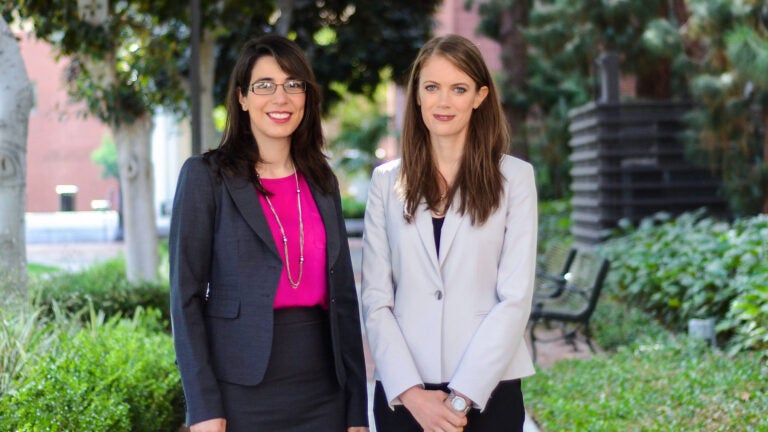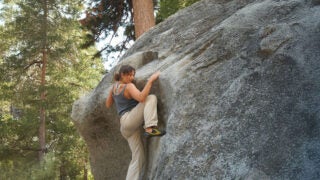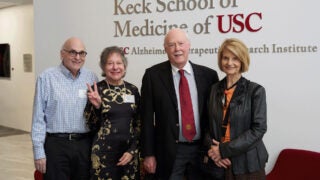
Nora Ayanian, left, and Kelly Sanders are among an elite group of innovators. (Photo/Peter Shin)
Two USC Viterbi researchers named among top ‘Innovators Under 35’
Nora Ayanian and Kelly Sanders are recognized by MIT Technology Review for their promising studies of robotics and energy
MIT Technology Review named two USC Viterbi School of Engineering researchers among its annual list of “Innovators Under 35.”
Roboticist Nora Ayanian, assistant professor of computer science and director of the Automatic Coordination of Teams Lab at USC, and environmental engineering scholar Kelly Sanders, an assistant professor in the Sonny Astani Department of Civil and Environmental Engineering and director of the Sustainable Systems Group at USC, were selected for their innovation and scholarship.
By making the annual list, Ayanian and Sanders join an elite group of global innovators, including Larry Page and Sergey Brin, the co-founders of Google; Mark Zuckerberg, the co-founder of Facebook, and Jonathan Ive, the chief designer of Apple. The Trojans join 11 other USC junior faculty members featured on the list since 2009.
“It is gratifying that the remarkable talent and promise of Nora Ayanian and Kelly Sanders were aptly recognized by MIT Technology Review,” said USC Viterbi Dean Yannis C. Yortsos. “Together with the other 11 USC Viterbi recognized in this list in the last seven years, they represent the new face of engineering — talented, innovative, charismatic, diverse and immensely promising. We could not be more proud of their achievements.”
Ayanian looks at multi-robot coordination
Ayanian’s research focuses on getting multi-robot systems out of the lab and into the real world. She creates end-to-end solutions for multi-robot coordination, which allow a user to specify the task at a high level, such as using a tablet app, and deliver code to make the team of robots work without roboticists on hand to monitor their progress.
As someone interested in control theory and efficient systems, she needs to know: How can we get robots to work well together as a group?
Other roboticists have studied schools of fish or flocks of birds in order to deconstruct their behavior and apply these findings to groups of robots. Ayanian is one of the few who “crowdsources” humans to deconstruct their behavior.
“Teams of humans are exceptionally good at coordination. Teams of robots, however, are clumsy at coordination, requiring extensive communication and computation,” Ayanian said. Such poor coordination is something Ayanian would like to eliminate.
Using an online multiplayer game she developed with funding from a National Science Foundation CAREER award this year, Ayanian is studying how people in groups behave when they need to complete group tasks, but have limited communication, sensing and motion capabilities — essentially putting “humans in the same situations as robots,” since communication is expensive and difficult for large teams of robots.
Her goal is to record how humans coordinate under these conditions, including how leaders emerge out of the group, how they communicate with each other with signaling and how humans decide if and when a task is completed.
Ayanian’s research is critical for helping teams of robots efficiently complete joint, complex tasks in warehousing, manufacturing, surveillance or perhaps even working together to rescue humans in a disaster.
In addition to considering communication and coordination channels, Ayanian is also working to ensure inter-robot collaboration by introducing the concept of diversity. Humans work best together when they have diverse capabilities and ways of thinking. By introducing diversity in how the robots act, they will not compete to complete the same task at the same time in the same way.
Sanders examines water and energy use
Sustainability expert Sanders’ focus is the energy-water nexus — the idea that producing a safe and reliable water supply requires a lot of energy, while producing a safe and reliable energy supply requires a lot of water. She has studied ways to optimize this relationship between energy and water services for nearly a decade.
Sanders currently is looking at novel ways to reduce the tension between energy production and water stress. Whether it’s electricity, oil and gas or biofuels, “all of the types of energy we consume take a lot of water to produce,” Sanders said. “With climate change and drought, a lot of power plants, and the fuels that they depend on, are becoming stressed due to unreliable water supplies, negatively affecting power reliability and adjacent ecosystems.”
The question Sanders now considers is “Can the electricity grid operate smarter when it comes to environmental performance of our power plants?” Through her research, she is trying to increase the power sector’s reliability and cleanliness.
“Today our power markets aim to minimize cost when selecting power plants to meet our electricity demands. Then we spend a lot of money trying to reverse the environmental and public health damages that these plants impose,” she said.
By integrating power grid models, her group simulates how hundreds of power plants operate under various operational rules and climatic conditions. Sanders and her team then assesses changes to cost, power system reliability, and impacts on local watersheds and human health. She also looks at opportunities for technical intervention, such as coupling water and power utilities to promote the use of recycled water for power plant cooling.
MIT Technology Review honorees will be recognized at the annual EmTech MIT conference held Oct. 18–20 in Cambridge, Mass.



